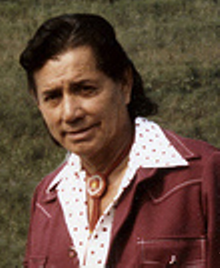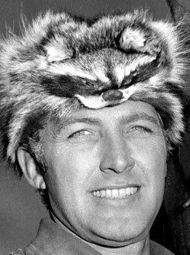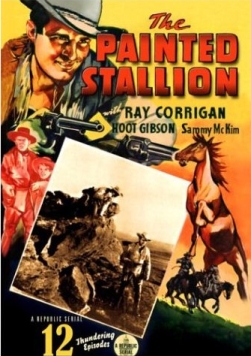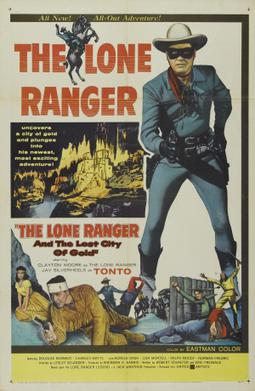
The Lone Ranger is a fictional masked former Texas Ranger who fought outlaws in the American Old West with his Native American friend Tonto. The character has been called an enduring icon of American culture.

Jay Silverheels was an Indigenous Canadian actor and athlete. He was well known for his role as Tonto, the Native American companion of the Lone Ranger in the American Western television series The Lone Ranger.

Tonto is a fictional character; he is the Native American companion of the Lone Ranger, a popular American Western character created by George W. Trendle and Fran Striker. Tonto has appeared in radio and television series and other presentations of the characters' adventures righting wrongs in 19th-century western United States.

The Legend of the Lone Ranger is a 1981 American Western adventure film directed by William A. Fraker and starring Klinton Spilsbury, Michael Horse and Christopher Lloyd. It is based on the story of The Lone Ranger, a Western character created by George W. Trendle and Fran Striker.

Clayton Moore was an American actor best known for playing the fictional western character the Lone Ranger from 1949 to 1952 and 1953 to 1957 on the television series of the same name and two related films from the same producers.

John Lewis Hart, also credited as John Hilton, was an American film and television actor. In his early career, Hart appeared mostly in westerns. Although Hart played mostly minor roles in some fairly well known films, he was probably best known for playing the character Hawkeye in the TV series Hawkeye and the Last of the Mohicans and replacing Clayton Moore in the television series The Lone Ranger for one season (1952–53).

Lynne Roberts, also credited as Mary Hart, born Theda May Roberts was an American film actress during the Golden Age of Hollywood. She appeared exclusively in what were referred to as B movies.

The Lone Ranger is an 1991 action-adventure game released by Konami for the Nintendo Entertainment System (NES). Released only in North America, it is based on The Lone Ranger radio and TV franchise, the latter which was still rerunning in syndication when the game was released. The player takes the role of the Lone Ranger himself as he engages against outlaws in side-scrolling, overhead, and even first-person segments. The Lone Ranger theme music is played prominently during the game, which includes a DPCM-coded voice clip of the ranger shouting his catch-phrase "Hi Yo Silver".

S O S Coast Guard is a 1937 Republic film serial. It was the seventh of the sixty-six serials made by Republic. The plot concerns the mad scientist Boroff attempting to sell a superweapon to the highest bidder, opposed by Coast Guard Lieutenant Terry Kent, for both personal and professional reasons.
George Washington Trendle was an American lawyer and businessman, best known as the producer of the Lone Ranger radio and television programs along with The Green Hornet and Sergeant Preston of the Yukon.

The Painted Stallion is a 1937 American Western film serial from Republic Pictures. It was the sixth Republic serial of the sixty-six made by that company. Western serials such as this made up a third of the serials from Republic, a studio that was also heavily involved in making B-Western feature films at the time.

The Lone Ranger Rides Again is a 1939 American Republic serial. It was a sequel to Republic's 1938 serial The Lone Ranger, which had been highly successful, and the thirteenth of the sixty-six serials produced by Republic.
Earle Graser was an American radio actor at radio station WXYZ, Detroit, Michigan. He was best known as the voice of the Lone Ranger from April 1933 to April 1941.

The Miracle Rider is a 1935 American Western film serial directed by B. Reeves Eason and Armand Schaefer for Mascot. It stars silent movie cowboy star Tom Mix in his last major film role.

Victor Daniels, known professionally as Chief Thundercloud, was an American character actor in Westerns. He is noted for being the first actor to play the role of Tonto, the Lone Ranger's Native-American companion, on the screen.

The Lone Ranger is an American Western television series that aired on the ABC Television network from 1949 to 1957, with Clayton Moore in the starring role. Jay Silverheels, a member of the Mohawk Aboriginal people in Canada, played the Lone Ranger's Indian companion Tonto.

The Lone Ranger and the Lost City of Gold is a 1958 American Western film in Eastmancolor released by United Artists. The second of two theatrical features specifically based on and continuing the TV show The Lone Ranger it stars Clayton Moore and Jay Silverheels, reprising their roles from the TV series. The first feature film was 1956's The Lone Ranger. No further films based on this specific version of the characters were made after this one.

The Lone Ranger is a 2003 American western action television film. It was an attempt by The WB to revive the Lone Ranger franchise for a new generation. The character first appeared in 1933 in a radio show conceived either by WXYZ (Detroit) radio station owner George W. Trendle, or by Fran Striker, the show's writer. The radio series proved to be a hit and spawned a series of books, an equally popular television show that ran from 1949 to 1957, comic books, and several movies.

Hi-Yo Silver is a 1940 American Western film, directed by William Witney and John English. It stars Lee Powell, Hi-Yo Silver, and Chief Thundercloud and was released on April 10, 1940. The film was created by condensing the fifteen chapters of the 1938 film serial The Lone Ranger.

Murder on the Yukon is a 1940 American adventure film directed by Louis J. Gasnier and written by Milton Raison. It is based on the 1931 novel Renfrew Rides North by Laurie York Erskine. The film stars James Newill, Polly Ann Young, Dave O'Brien, Al St. John, William Royle and Chief Thundercloud. The film was released on February 25, 1940, by Monogram Pictures.














